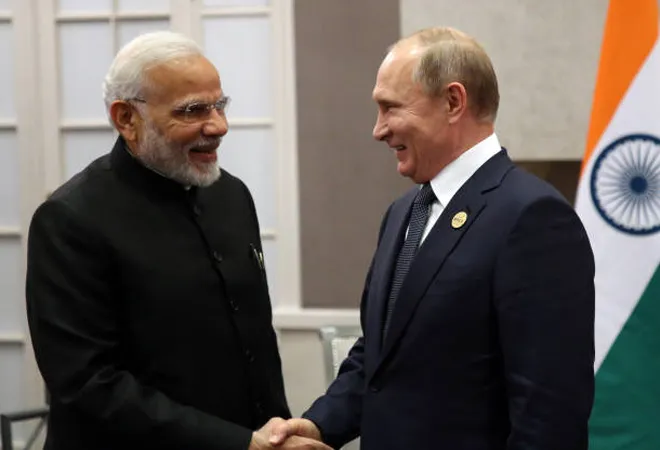
The Director of Federal Service for Military-Technical Cooperation (FMSTC), Dmitry Shugayev, recently
told Russian news agencies that the first supplies of the S-400 air defence missile systems have already been started. This is a part of the US $5.5 billion deal for five long-range surface-to-air missile systems that the two countries signed in 2018.
This development in the Indo-Russian dynamic must be contextualised amidst serious speculations of a rift between the two countries owing to India and Russia’s growing closeness with the United States and China respectively. However, a detailed look at the trajectory of Indo-Russian ties in the face of rising skepticism regarding the durability of this “time-tested” relationship clearly indicates that they remain quite stable, albeit with some hiccups.
It is no secret that Indo-Russian relations have often been
characterised by a great degree of political and strategic trust ever since the 1960s. In spite of India’s official policy of non-alignment during the Cold War years, it shared a close relationship with the Soviet Union, symbolised by the Indo-Soviet Treaty of Friendship and Cooperation signed in 1971, while the United States had forged an intimate nexus with neighbour Pakistan. May it be
supporting India’s nuclear tests in the 1970s publicly, unlike the disapproving United States, Soviet machinery constituting a vast majority of Indian defence infrastructure since the 1970s, or using its veto influence at the UN Security Council to quash resolutions seeking UN intervention in Kashmir on various occasions, Russia has always proven to be a trustworthy friend. Conversely, India too has
called for a peaceful dialogue on Crimea while avoiding any criticism of Russian policy on the issue.
A detailed look at the trajectory of Indo-Russian ties in the face of rising skepticism regarding the durability of this “time-tested” relationship clearly indicates that they remain quite stable, albeit with some hiccups.
In the aftermath of the collapse of the Soviet Union, as the Russian federation endeavoured to re-construct its foreign policy, India too, on the path of liberalising the economy had majorly started looking towards the West. In pursuit of addressing domestic priorities, the relationship between the two countries inevitably
lost spark for a few years. But, as a testament to their longstanding ties, the lacunae in bilateral engagement did not last very long as both the countries signed a treaty on Friendship and Cooperation in 1993, followed by a Treaty on Military-Technical Cooperation in 1994. Thus, by the mid 1990s, there was clear revival in relations from the slight setback.
Despite this historically consistent and robust relationship, Indo-Russian ties have been going through a thorny patch, more so since 2014 following western sanctions which compelled Russia to bolster its economic and strategic ties with China. In the backdrop of India’s deteriorating ties with China over the years, this budding Sino-Russian camaraderie has definitely caused concerns for India. The shared aim of countering a galloping China is also one of the key factors that has brought India closer to the United States, which has undoubtedly made Russia uncomfortable because of its progressively worsening ties with the west lately.
Russia has opposed the US’ Indo-Pacific Strategy that India is an instrumental part of, while also sharply
criticising the revival of the QUAD as a US-led ‘persistent, aggressive and devious’ policy intended to ensnare India in its anti-China games. It has accused the US of trying to sabotage the tight relationship between Delhi and Moscow. These differences, coupled with India’s trade numbers with Russia having ceased to live upto potential in comparison to Sino-Russian trade, has led many to raise alarms about the approaching end of this steady friendship.
However, the decision to go through with the deal concerning the S-400 defence systems surely suggests the contrary. India’s procurement of these could potentially trigger American sanctions under the Countering America’s Adversaries Through Sanctions Act (CATSAA), which seeks to limit the sale of Russian arms to other states in order to
deprive the Russian military-industrial establishment of funds. Even though there are provisions of waivers within CATSAA, there are no vivid indications that these would apply to India. Moreover, back in February, an official from the Biden administration had reportedly
told CNBC-TV18 that this deal between India and Russia could trigger sanctions.
The shared aim of countering a galloping China is also one of the key factors that has brought India closer to the United States, which has undoubtedly made Russia uncomfortable because of its progressively worsening ties with the west lately.
In spite of the threat of these sanctions, which could somewhat hamper the progress that has been made in Indo-US relations in recent years, India has made it extremely clear that it will continue with procurement of these systems which are considered important for national security. The fact that India willing to risk its relationship with the US to pursue its own independent policy certainly points towards an existing pragmatism regarding doing what is best for its own interests. This approach would also deter India from souring its relations with a durable and reliable partner like Russia solely because of its cordial relations with the United States. The looming threat of these sanctions also reinforces the image of US unreliability as a partner, as Sreemoy Talukdar
writes, which makes Russia’s trustworthiness as a long-term partner invaluable.
Barring this particular deal, there are also ample indications re-emphasising the stability in Indo-Russian ties, which the skeptics seem to have glossed over. Despite India wanting to
reduce its arms dependence and diversifying its arms suppliers since 2018, the two countries have still
signed mega deals in the past three years and more are expected to be signed in the upcoming years. As Shekhar Gupta also very interestingly
pointed out, if India goes to war right now, an overwhelming majority of its equipment would be of Russian origin because
roughly 86 percent of India’s defence equipment is of Russian origin.
Diplomatically too the two countries have continued to engage extremely frequently. The two countries regularly engage as parts of various multilateral institutions, where Indian and Russian representatives regularly meet on the sidelines to discuss issues, underscoring the intimate nature of their ties. Indian Foreign Secretary Harsh V. Shringla’s
first overseas trip outside South Asia during the ongoing coronavirus pandemic was to Russia, underlining the strategic relevance that the country holds. Prime Minister Modi and President Putin have met each other on numerous occasions since 2014 and also correspond telephonically from time to time.
The two countries regularly engage as parts of various multilateral institutions, where Indian and Russian representatives regularly meet on the sidelines to discuss issues, underscoring the intimate nature of their ties.
As India hosts President Vladimir Putin in December for the annual bilateral summit, the two countries are also set to
hold their first ever 2+2 ministerial dialogue alongside. India currently holds this 2+2 mechanism with its QUAD partners US, Japan and Australia. Russia getting added to that list only shows that India still very much views it as a valuable strategic partner but prefers to keep its relationship with Russia independent of its equation with the United States and the QUAD. Ahead of the visit, the defence ministry is also expected to finalise a
deal roughly worth INR 5,000 crores with Russia for the manufacture of 7.5 lakh AK 203 assault rifles, among other potential agreements in the areas of technology and trade.
It must be kept in mind that these diplomatic and defence engagements have kept pace amid increasing talks about Indo-Russian ties being a casualty of changing global dynamics. There have surely been issues where the two countries have not looked eye to eye, but that is a general characteristic of any bilateral relationship. India’s decision to proceed with the defense deals irrespective of US pressure sends a message that its preferred foreign policy will not be stifled by external pressure, which is quite congruent with the Indo-Russian common strategic
goal to try and build a ‘multipolar’ or ‘polycentric’ world. This common strategic thinking which acts as one of the main pillars of this enduring relationship makes it very difficult for the two countries to drift too far apart notwithstanding some disagreements.
The views expressed above belong to the author(s). ORF research and analyses now available on Telegram! Click here to access our curated content — blogs, longforms and interviews.



 The Director of Federal Service for Military-Technical Cooperation (FMSTC), Dmitry Shugayev, recently
The Director of Federal Service for Military-Technical Cooperation (FMSTC), Dmitry Shugayev, recently  PREV
PREV


